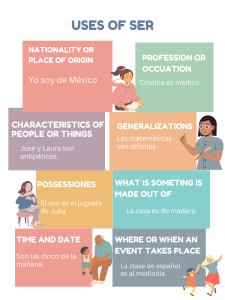Partes de una frase / parts of a sentence
In this section we are going to learn the different parts of a simple sentence and how to put sentences together in Spanish. A lot of the components of a sentence are the same in English, but we are going to go back to basics to make sure that we all know each component and their definition.
Part of speech whether it is oral or written, has several parts. You need a subject, a verb and a predicate to have a complete sentence to express a “complex” idea. When we put a sentence together, we can have several ways to do it when it come to simple sentence for a beginner speaker. The following ways are the two ways that you will learn in this section.
- Personal pronoun + verb (conjugated) + adjective
- Article + noun + verb + adjective
NOMBRES / NOUNS
A noun is a word used to identify people, animals, places, things, or ideas.
In Spanish all nouns have gender; either masculine or feminine. – All nouns have a gender, which determines the gender of any adjectives or determiners that modify it.
As in English, nouns in Spanish also have a number; singular or plural.
- Because grammatical gender is fairly arbitrary, it is essential to memorize a noun’s gender along with its spelling and pronunciation.
Nouns for living things
| Masculine | Feminine |
| Ending- o | Ending -a |
| El amigo- friend | La amiga- female friend |
| Ending -or | Ending -ora |
| El profesor- professor | La profesora- female professor |
| Ending –ista | Ending –ista |
| El turista- Turist | La turista- female turist |
Nouns for non-living things
Inanimate objects such as cars are categorized as either masculine or feminine (there is no neuter gender for Spanish nouns).
| Masculine | Feminine |
| Ending – o | Ending- a |
| El libro- the book | La casa – the house |
| Ending -ma | Ending -ción |
| El problema- the problem | La canción- the song |
| Ending – s | Ending -dad |
| El país – the country | La igualdad- equality |
ARTÍCULOS / ARTICLES
There are two times of articles in Spanish.
Definite articles
| Singular | Plural |
| El (Masculine) | Los (Masculine) |
| La (Femenine) | Las (Femenine) |
Indefinite articles
| Singular | Plural |
| Un (Masculine) | Unos (Masculine) |
| Una (Femenine) | Unas (Femenine) |
PRONOMBRES PERSONALES / PERSONAL PRONOUNS
They are the subject that carries out the verb in a sentence. In Spanish, you can omit the subject pronouns because the conjugation of the verb implies who is the subject. You can use the pronoun to add emphasis.
First person
| Singular | Plural |
| I- Yo | We- Nosotros / Nosotras |
Second person
| Singular | Plural |
| You (Informal) – Tú | You all- Vosotros / Vosotras (Used in Spain/ not in Latin America) |
Vos- is used in Argentina instead of tú and has a completely different conjugation form.
Third person
| Singular | Plural |
| Him/her- él/ella | They- Ellos/ Ellas |
| You (formal)- Usted | You all- Ustedes (Used in most Latin American countries) |
Masculine and Feminine
Some pronouns have masculine and feminine forms. You can identify them with the ending “o” for masculine and “a” for feminine (except for “él”).
Nosotros and nosotras
Vosotros and vosotras
Ellos and ellas
Él and Ella
When the group includes only males, you will use the masculine endings.
If the group includes only females, you will use the feminine endings.
When the group is mixed, you will use masculine endings.
Usted and Tú
The use of you (tú and used) and used varies culturally between different Spanish speaking countries.
For example: In Costa Rica, people only use usted.
VERBO SER
Ser and Estar both mean “to be” in English, but both are used differently depending on what the speaker intends to address. Below you will find the different uses of each.
Verb SER (to be)
| Singular | Plural |
| Yo- Soy | Nosotros/as- Somos |
| Tú- Eres | Vosotros/as- Sois |
| Él/Ella/Usted- Es | Ellos/Ellas/Ustedes- Son |
Ser and estar are two verbs that mean to be. Even though they mean the same thing, they are not interchangeable. Below are the uses for the verb ser.

ADJETIVOS DESCRIPTIVOS/DESCRIPTIVE ADJECTIVES
A descriptive adjective is a word that modifies the noun. It has to agree in gender (feminine or masculine) and in number (singular and plural) with the noun that is modifying.
Adjectives follow the nouns that they are describing, while in English the noun follows the adjective.

As mentioned before, adjectives have to agree with the noun in gender (feminine and masculine) and in number (singular and plural). Let’s look at how the adjectives are sorted by gender;
|
FEMENINO |
MASCULINO |
|
adjective ends in -a or -as La chica guapa Las chicas guapas |
Adjectives that end in -o or -os El chico guapo Los chicos guapos |
|
Adjectives that end in -e or -ista Ella es inteligente Ella es idealista |
Adjectives that end in -e or –ista El es inteligente El es idealista |
|
Adjectives that end in -dor add an -a Ella es conservadora |
Adjectives that end in -dor El es conservador |
If we look at the table above you will notice that to the adjectives that end in “-a” or “-o” in order to make them plural we just add an “s”. But what about the rest of the adjectives? If the adjective ends in a vowel, all you have to do is add an “s”. If it ends in a consonant, you add “-es”.
Singular ending in vowel: Ella es inteligente. She is intelligent.
Plural ending in vowel: Ellas son inteligentes. They are intelligent.
Singular ending in consonant: El es conductor. He is a driver.
Plural ending in consonant: Ellos son conductores. They are drivers.
(Remember, if you make one word plural the rest of the sentence structure has to do so as well)
Licensing and Attribution:
Orthografía content on this page was remixed from Español por el mundo by Gemma Morawski and Ani Alcocer, licensed under a Creative Commons Attribution 4.0 International License. Adaptations include voice pronunciations provided by Gemma Morawski and openly-licensed images throughout the H5P flashcards attributed on each card via the H5P editing dashboard and forvo.com . Further adaptations include practice activities created by Gemma Morawski via H5p. Images are created by Gemma Morawski with canva.

